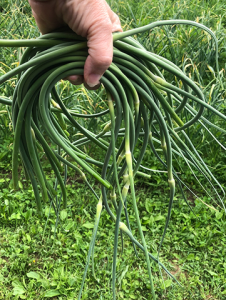Embracing the Versatility of Garlic Scapes
In the world of culinary treasures, garlic scapes are often an overlooked gem.
These elegant and vibrant green shoots are the flowering stalks of garlic plants, bursting with unique flavors and providing an exciting addition to various garlic scape dishes. Today, we embark on a journey to explore the wonders of scapes, including their types, ideal harvesting time, reasons for cutting them, and delicious ways to incorporate them into your meals.

Scapes in the field
What are Garlic Scapes?
Garlic scapes are the curly, slender shoots that emerge from hard-necked garlic plants. They appear as graceful green coils with small bulbils or flower buds at the tip. While they may seem like mere adornments, these scapes are packed with a milder garlic flavor and possess a delightful crunch that adds a delightful twist to your culinary endeavors.
Types of Garlic that Produce Scapes:
Not all varieties of garlic produce scapes. Typically, hard-necked garlic varieties are the ones that yield these delectable shoots. Some popular hard-necked garlic varieties include Rocambole, Porcelain, and Purple Stripe. Each variety has its distinct flavor profile, ranging from mild and sweet to robust and pungent, providing endless possibilities for culinary experimentation.

Types of Garlic that Produces Scapes
When to Harvest Scapes:
Harvesting garlic is an art in itself. The ideal time to cut garlic scapes is when they have curled once or twice and before they straighten out fully. This stage ensures a tender and flavorful scape, making it easier to incorporate into dishes. Timing is crucial, as allowing the scape to mature fully diverts the plant’s energy towards flower and seed production, potentially affecting the size and quality of the garlic bulb.

Cutting Garlic
Why Should You Cut Garlic Scapes?
Cutting scapes serves multiple purposes. First and foremost, removing the scapes diverts the plant’s energy back into the garlic bulb, encouraging its growth and ensuring a plumper and more substantial harvest. Moreover, cutting scapes prevents the development of bulbils, small seed-like structures, which can drain the plant’s resources. By snipping off the scapes, you not only enhance the bulb’s quality but also maintain the plant’s overall health.
Utilizing Scapes in the Kitchen:
Once you’ve harvested your scapes, a world of culinary possibilities unfolds before you. These versatile shoots can be used in numerous ways, adding a unique and delightful touch to your dishes. Here are a few ideas to get you started and some additional recipes here:

Pesto
Pesto:
Blend scapes with pine nuts, Parmesan cheese, olive oil, and a dash of lemon juice to create a vibrant and flavorful pesto. This versatile sauce can be used as a dip, a spread, or tossed with pasta.
Stir-Fries & Sautées:
Chop scapes into bite-sized pieces and incorporate them into stir-fries or sauté them with other vegetables. Their mild garlic flavor adds depth to the dish without overpowering other ingredients.

Stir Fry
Grilling:
Brush scapes with olive oil, sprinkle with salt and pepper, and grill them until tender and slightly charred. Grilled scapes make a fantastic side dish or a delightful addition to salads.

Grilled
Pickling:
Transform your garlic scapes into tangy pickles by immersing them in a mixture of vinegar, water, sugar, and spices. Allow them to pickle for a few days before enjoying their zesty crunch alongside sandwiches or as a condiment.

Pickled
In conclusion, scapes are not only a byproduct of growing garlic but also a versatile culinary ingredient that adds a unique twist to your dishes. By harvesting the scapes, you promote the growth of larger garlic bulbs and gain access to a mild and flavorful ingredient that can be sautéed, made into pesto, pickled, or grilled. So, the next time you see those curly green shoots emerging from your garlic plants, remember to cut them and let your creativity take over in the kitchen.





